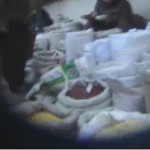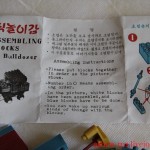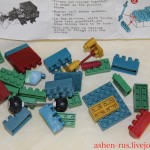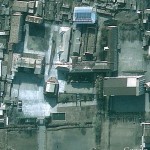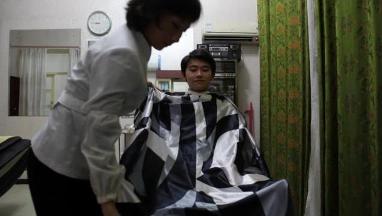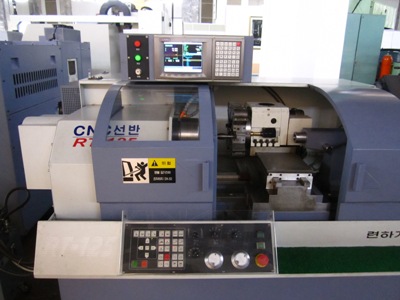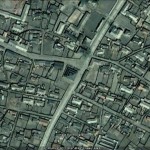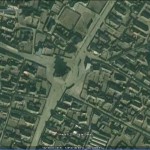UPDATE 7 (3/15/2011): According tothe AP (via USA Today), North Korea’s gymnasts have been banned from the 2012 London Olympics:
North Korea’s gymnasts are still barred from the 2012 London Olympics as punishment for age falsification, despite the country’s reform efforts.
North Korea asked the International Gymnastics Federation for leniency last month after firing the outgoing president of its Gymnastics Association, its international director and her secretary, and banning them from gymnastics, according to a statement Tuesday from the FIG. North Korea also approved an identification and registration process for its gymnasts.
But FIG president Bruno Grandi said North Korea had failed to appeal in time, and he wouldn’t interfere with the governing body’s disciplinary procedures.
North Korea was given 21 days to appeal after the FIG issued a two-year ban from international competition in November, its second punishment for age falsification. The FIG imposed the current sanction, which lasts until Oct. 5, 2012, after finding that Hong Su Jong listed three different birth dates (1989, 1985 and 1986) in registering for international competitions from 2003 until this year, including the 2004 Athens Olympics.
North Korea has also banned Hong for life and ordered her to return all medals and titles “as the result of grave negligence and damage caused to the Association’s reputation,” according to the FIG release.
The FIG began investigating Hong after she entered last month’s worlds using the third different birth date of her career — 1989. She won the silver medal on vault at the 2007 worlds listing 1986 as her birth year. She competed in Athens using a birth year of 1985, which, if she was born in 1989, would have made her 14 or 15 — too young to compete. Gymnasts must turn at least 16 in the calendar year of an Olympics to be eligible.
North Korea was banned from the 1993 world championships after the FIG discovered that Kim Gwang Suk, the 1991 gold medalist on uneven bars, was listed as 15 for three years in a row.
Age falsification has been a problem in gymnastics since the 1980s, when the minimum age was raised from 14 to 15 to help protect still-developing athletes from serious injuries. The minimum age has been 16 since 1997, and the FIG now requires gymnasts competing at most international events to have a license proving their age for their entire career.
UPDATE 6 (11/5/2010): According to the International Gymnast:
North Korea is suspended from international competition until October 2012 for age falsification and false registration, the International Gymnastics Federation announced Friday.
As IG reported in September, North Korean gymnast Hong Su Jong’s birth year has appeared over the years as 1985, 1986 and 1989. For the 2010 World Championships, the North Korean federation submitted Hong’s birth year as 1989, meaning she was underage at the 2004 Olympic Games in Athens.
On Oct. 5, the FIG’s Disciplinary Commission provisionally suspended the North Korean federation for 30 days, leaving the country out of October’s world championships in Rotterdam. North Korea appealed but the FIG upheld the suspension, stating the federation’s offered excuses for the varying birth dates were not credible.
Hong’s case is the second age falsification offense for North Korea. The North Korean women were banned from the 1993 World Championships after the FIG discovered gymnast Kim Gwang Suk had been registered as being 15 from 1989-1991.
The FIG Presidential Commission followed the Disciplinary Commission’s recommendation to suspend North Korea for two years, from Oct. 6, 2010 to Oct. 5, 2012, and to forbid its participation “in any capacity in any competition or activity authorised or organised by the FIG, any Union, any National Federation, any club or in any international event.”
The FIG stated that Hong also is not allowed to compete in any domestic competition during that period of time.
“The FIG’s decision is a clear signal to those who would willfully disregard the current rules surrounding gymnast age. The health of its athletes and respect for the law are among the International Gymnastics Federation’s highest priorities,” the FIG stated.
The sanction includes not only the women’s team, but also North Korea’s male gymnasts and rhythmic gymnasts. Notably this affects male standout Ri Se Gwang, the only gymnast who has competed two vaults of the maximum difficulty of 7.2 (piked double front-half and Tsukahara double back with a full twist).
The latest birth date for Hong Su Jong — March 9, 1989 — confirms the long-held suspicion that she and her sister, Hong Un Jong, are twins. Hong Un Jong, whose date of birth has been listed consistently as March 9, 1989, won the gold medal on vault at the 2008 Olympic Games in Beijing. Hong Un Jong did not compete at the 2004 Olympics.
The FIG also hit the North Korean federation with a fine of 20,000 Swiss Francs (approximately $20,800). Several years ago, the North Korean federation was temporarily suspended from the FIG for being unable to pay its membership dues.
The FIG showed leniency, however, by not stripping Hong of the silver medal she won on vault at the 2007 World Championships in Stuttgart for the infraction of “false registration.” Although a 1989 year of birth would have been made her age eligible in 2007, Hong was registered in Stuttgart using a passport that listed her year of birth as 1986. All passports are photocopied, the FIG told IG.
North Korea may appeal the sanction in writing within 21 days, the FIG stated.
UPDATE 5 (11/5/2010): According to AFP:
North Korean gymnast Hong Su Jong has been banned for two years by the International Gymnastics Federation (FIG) for lying about her age.
The FIG provisionally suspended Hong, a silver medal winner on the vault at the 2007 world championships, on October 6 after discovering she had registered for various international events claiming to be three different ages.
“The FIG’s decision is a clear signal to those who would wilfully disregard the current rules surrounding gymnast age,” the sports world governing body said in a statement on Friday.
“The health of its athletes and respect for the law are among the International Gymnastics Federation?s highest priorities.”
The ban runs until October 5, 2012, with the North Korean gymnastics federation ordered to pay a 20,000 Swiss Franc (15,000 euros) fine.
The gymnast and her federation have 21 days to appeal.
Hong had been registered with three different birth years for international competition over the past six years.
At the Athens Olympics in 2004 she was down as having been born on Match 9, 1985 but the date of March 9, 1989 was given for the worlds in Rotterdam last month which North Korea were excluded from competing in.
At the same time, she was registered with a date of March 9, 1986, birthdate at the 2007 world championships, where she won the silver medal on vault.
If Hong was born in 1989, she would have been ineligible to compete in Athens. Gymnasts must turn 16 in the calendar year of an Olympics in order to be eligible.
North Korea were banned from the 1993 worlds after FIG discovered that Kim Gwang Suk, the 1991 gold medallist on uneven bars, was listed as 15 years for three straight years.
UPDATE 4 (10/30/2010): FIG to decide DPRK case soon. According to Intlgymnast.com:
The International Gymnastics Federation will decide with the next 10 days when North Korea’s gymnasts can return to competition following an age falsification case, an FIG spokesman told IG.
The FIG’s Disciplinary Commission has invited the North Korean federation’s representatives to hearings Tuesday and Wednesday at the FIG headquarters in Lausanne.
On Oct. 6, the FIG provisionally suspended the North Korean gymnastics federation for 30 days for suspicion of age falsification and false registration in the case of Hong Su Jong. The North Korean federation registered Hong, a 2004 Olympian, under three different birth years: 1985, 1986 and 1989. A birth year of 1989 — used to register Hong for the 2010 World Championships — would have made her ineligible for the 2004 Olympics.
While the FIG’s Disciplinary Commission investigated the case, the commission’s president acted to provisionally suspend the federation for 30 days, preventing the team from competing at last week’s world championships in Rotterdam.
The North Korean federation immediately appealed the suspension, but it was rejected, and the team was unable to take part in Rotterdam.
“The provisional suspension will expire on Nov. 8,” the FIG’s Philippe Silacci said. “The commission will made a decision prior to this date.”
At immediate stake is North Korea’s participation in the 16th Asian Games, which begin Nov. 13 in Guangzhou, China. The North Korean women were second as a team at the 2006 Asian Games in Doha, where Hong Su Jong also placed third all-around and first on uneven bars.
The FIG’s Disciplinary Commission will present its findings to the FIG Presidential Commission, which will determine if further disciplinary action is warranted. It is doubtful that the FIG would issue a substantial monetary fine to the North Korean federation, which at one time was suspended temporarily for being unable to pay its FIG dues.
The Hong Su Jong case is North Korea’s second offense. The FIG banned the North Korean women from competing at the 1993 World Championships after gymnast Kim Gwang Suk was registered as being 15 in 1989, 1990 and 1991.
The FIG also could decide to strip Hong of the silver medal she won on vault at the 2007 World Championships, even though she was age eligible at the time, because of the “false registration.” If Hong Su Jong’s year of birth is confirmed to be 1989, it would mean she was registered using a falsified passport in Stuttgart, where her year of birth was listed as 1986.
Hong’s sister, Hong Un Jong, won the 2008 Olympic gold medal on vault. The latest birth date for Hong Su Jong confirms she and Un Jong are twins.
UPDATE 3 (10-14-2010): DPRK gymnasts barred from 2012 olympics. According to the AP via USA Today:
North Korea will not be able to send teams to the 2012 London Olympics after international gymnastics officials rejected the federation’s appeal of a ban imposed because a gymnast falsified her age.
The International Gymnastics Federation said its appeal tribunal ruled Thursday that North Korean explanations did not justify lifting a provisional 30-day suspension handed down last week because of Hong Su Jong’s violation of age rules. The ban prohibits North Korea from competing at any international competitions, including the world championships that begin Saturday in Rotterdam, Netherlands, and are the first step in qualifying for the London Games.
The top 24 teams at worlds advance to next year’s world championships in Tokyo. North Korea still might be able to send individual athletes to London depending on whether more sanctions are imposed.
North Korea can make a final challenge at the Court of Arbitration for Sport.
The FIG imposed its ban after finding that Hong had entered worlds using the third different birth date of her career. She listed her birth year as 1989, but FIG documents show that she competed at the 2004 Athens Olympics and the 2006 worlds using a birth year of 1985. She won the silver medal on vault at the 2007 worlds listing 1986 as her birth year.
If Hong was born in 1989, she would have been ineligible to compete in Athens. Gymnasts must turn at least 16 in the calendar year of an Olympics to be eligible.
This is the second time North Korea has been punished for age falsification. The federation was banned from the 1993 world championships after the FIG discovered that Kim Gwang Suk, the 1991 gold medalist on uneven bars, was listed as 15 for three years in a row.
Age falsification has been a problem in gymnastics since the 1980s, when the minimum age was raised from 14 to 15 to help protect still-developing athletes from serious injuries. The minimum age has been 16 since 1997.
The FIG requires all gymnasts who represent their countries at most international meets to have a license that proves their age for their entire career.
UPDATE 2 (10-13-2010): The North Koreans have appealed their suspension. According to International Gymnast Magazine:
After it was discovered that three different birth years had followed the March 9 birth date (1985, ’86 and ’89) of Hong Su Jong (pictured here) since she competed in the 2004 Olympics, the President of the FIG Disciplinary Commission provisionally suspended the North Korean federation as of Oct. 6, 2010, for 30 days. North Korean officials were given five days to file appeal, which they did on Oct. 11.
The appeal will be judged by the President of the FIG Appeal Tribunal within five days. The world championships in Rotterdam, which begin on Oct. 16, serve as a qualifying competition to the 2011 Worlds in Tokyo.
“If the decision is final and stands, [North Korea] could only participate with individual gymnasts in Tokyo,” FIG Secretary General Andre Gueisbuhler told IG.
Gueisbuhler also said that if the suspension is upheld, it would affect all gymnastics disciplines of the North Korean federation, men and women.
UPDATE 1 (10-7-2010): The North Koreans have been suspended. According to USA Today:
North Korea’s gymnasts have been suspended from the world championships starting next week because one team member’s age had been falsified.
The International Gymnastics Federation said Thursday it provisionally suspended North Korea’s federation and gymnast Hong Su Jong for 30 days, ruling them out of the worlds being held Oct. 16-24 in Rotterdam and any other international or national event.
North Korea which entered four women, including Hong, and two men to compete at the worlds can appeal to the FIG within five days.
The FIG’s disciplinary commission met Wednesday and noted that Hong’s entry for the worlds had her birth date as March 9, 1989.
FIG documents show that she competed at the 2004 Athens Olympics and the 2006 worlds using a birth year of 1985, and won the silver medal on vault at the 2007 worlds using 1986. American Alicia Sacramone was the bronze medalist on vault in 2007.
If Hong was born in 1989, she would have been ineligible to compete in Athens. Gymnasts must turn at least 16 in the calendar year of an Olympics to be eligible.
“The USA has always played very correctly and followed the rules. We would be very happy to see other countries doing the same thing,” said Martha Karolyi, coordinator of the U.S. women’s team. “From time to time, it’s frustrating to see some people are not playing by the rules. I’m very happy the FIG stands up and is trying to track down these mistakes.”
Age falsification has been a problem in gymnastics since the 1980s, when the minimum age was raised from 14 to 15 to help protect still-developing athletes from serious injuries. The minimum age has been 16 since 1997.
North Korea was banned from the 1993 worlds after the FIG discovered Kim Gwang Suk, the 1991 gold medalist on uneven bars, was listed as 15 for three years in a row.
Earlier this year, the International Olympic Committee stripped China of its team bronze medal from the 2000 Sydney Olympics for using an underage gymnast.
That case followed an investigation by FIG into unproven claims that some of China’s gold-medal team at the 2008 Beijing Olympics could have been as young as 14.
The governing body now requires all junior and senior gymnasts who represent their countries at most international meets to have a license that acts as proof of their age for their entire career.
ORIGINAL POST: According to the AP:
International gymnastics officials are investigating another case of possible age falsification, this time of a North Korean gymnast who listed three different birth dates.
North Korea and Hong Su Jong will be given a chance to explain the discrepancies at a hearing and in written statements, the International Gymnastics Federation said Saturday.
Hong’s birth date is March 9, 1989, on the entry list for the world championships this month in Rotterdam, Netherlands. But she had a March 9, 1985, birth date at the 2004 Athens Olympics and the 2006 world championships, and a March 9, 1986, birth date at the 2007 world championships, where she won the silver medal on vault.
If Hong was born in 1989, she would have been ineligible to compete in Athens. Gymnasts must turn 16 in the calendar year of an Olympics to be eligible.
…
Age falsification has been a problem in gymnastics since the 1980s, when the minimum age was raised from 14 to 15 to help protect still-developing athletes from serious injuries. The minimum age was raised to its current 16 in 1997. North Korea was banned from the 1993 world championships after the FIG discovered Kim Gwang Suk, the 1991 gold medalist on uneven bars, was listed as 15 for three years in a row.
I think instances of cheating are fairly rare with North Korean teams though I do remember two other reports. The first is when North Koreans were caught cheating at the International Mathematical Olympics. The second report is from the 2008 Olympics where two athletes tested positive for doping.
Read the full story here:
NKorean gymnast investigated for 3 birth dates
AP (Via USA Today)
10/2/2010

